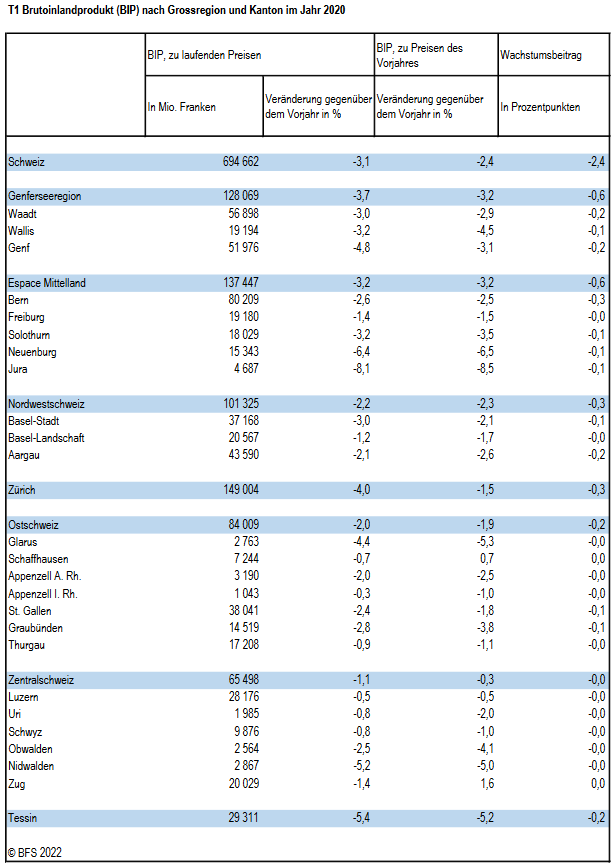21.10.2022 – 2020 was marked by the COVID-19 pandemic, which affected the entire regional economic fabric in Switzerland. National growth in gross domestic product (GDP) fell to –2.4% at the previous year’s prices and almost all cantons recorded a decline in activity. Jura was the most affected (–8.5%), followed by Neuchâtel (–6.5%), Glarus (–5.3%) and Ticino (–5.2%). Only the cantons of Zug (1.6%) and Schaffhausen (0.7%) recorded an increase. These figures come from the latest estimates of the Federal Statistical Office (FSO). In 2020 the global economy experienced a turning point. In Switzerland, the national GDP fell by 2.4% at the prices of the previous year. Unsurprisingly, almost the entire manufacturing sector and energy supply were affected. The decline
Topics:
Swiss Statistics considers the following as important: 2.) Swiss Statistics - Press Releases, 2) Swiss and European Macro, Featured, newsletter, Switzerland Gross Domestic Product, Switzerland Gross Domestic Product QoQ
This could be interesting, too:
Nachrichten Ticker - www.finanzen.ch writes Die Performance der Kryptowährungen in KW 9: Das hat sich bei Bitcoin, Ether & Co. getan
Nachrichten Ticker - www.finanzen.ch writes Wer verbirgt sich hinter der Ethereum-Technologie?
Martin Hartmann writes Eine Analyse nach den Lehren von Milton Friedman
Marc Chandler writes March 2025 Monthly
| 21.10.2022 – 2020 was marked by the COVID-19 pandemic, which affected the entire regional economic fabric in Switzerland. National growth in gross domestic product (GDP) fell to –2.4% at the previous year’s prices and almost all cantons recorded a decline in activity. Jura was the most affected (–8.5%), followed by Neuchâtel (–6.5%), Glarus (–5.3%) and Ticino (–5.2%). Only the cantons of Zug (1.6%) and Schaffhausen (0.7%) recorded an increase. These figures come from the latest estimates of the Federal Statistical Office (FSO).
In 2020 the global economy experienced a turning point. In Switzerland, the national GDP fell by 2.4% at the prices of the previous year. Unsurprisingly, almost the entire manufacturing sector and energy supply were affected. The decline in services was less pronounced, but was still clearly noticeable. Transport, accommodation and gastronomy, travel agencies and cultural and sporting activities were particularly badly affected. However, some sectors recorded positive growth in 2020. Tobacco, chemical, automotive, waste treatment, and information and financial services all rose. Despite the overall negative trend, the different developments across Switzerland and the dynamics in some sectors, which ran counter to the general decline, had different regional effects depending on the cantonal economic structure. General decline in cantonal GDPThe economic crisis affected most of the regional economic fabric. Growth ranged between –8.5% and +1.6%. Non-financial activities and the primary sector developed negatively in practically all cantons. In contrast, financial services registered an increase in most cantons. The situation was most severe in the cantons of Jura (–8.5%), Neuchâtel (–6.5%), Glarus (–5.3%), Ticino (–5.2%) and Nidwalden (–5.0% ) to accomplish. They suffered particularly badly from the slowdown in growth or even the cessation of activities in their regions and posted a decline in almost all non-financial sectors. The cantons of Zug (1.6%) and Schaffhausen (0.7%) were least affected by the decline in economic activity in 2020, followed by Lucerne (–0.5%), Schwyz (–1.0%) and Thurgau ( –1.1%). In Zug and Schaffhausen, growth is primarily supported by economic services and the administration and management of companies and businesses. Lucerne held up relatively well as non-financial activities fell less sharply. In the cantons of Schwyz and Thurgau, the financial sector acted as a growth driver. In all of these cantons, the overall performance of the non-financial sector was not quite as negative as in the other cantons. Different dynamics in the contributions to growthThe exceptional year 2020 meant that the contributions of the cantons to national economic growth aligned with each other. While most of the contributions to growth have so far come from one or two economic centers, in 2020 six cantons each contributed -0.2% or less to national negative growth (Aargau -0.2%, Ticino -0.2%, Geneva -0.2%, Vaud -0.2%, Berne -0.3%, Zurich -0.3%). These results make it clear that the economic crisis of 2020 did not spare any region of Switzerland. |
Labor productivity by major region
Labor productivity in Switzerland increased by 1.4% in 2020 at the prices of the previous year. This increase is due to the fact that labor input fell more sharply (–3.7%) than GDP (–2.4%). Although in Ticino both the GDP (–5.2%) and the number of hours actually worked (–10.9%) have experienced the greatest decline in a cantonal comparison, labor productivity has grown the most there. Conversely, productivity in north-western Switzerland fell in 2020 (–1.6%) after developing positively in 2019 (3.4%). The reason for this is the fact that employment in this region, which includes the cantons of Basel-Stadt and Basel-Landschaft in particular, has declined proportionally less than in the other regions. In these two cantons, many jobs are in the pharmaceutical industry, healthcare and public administration, which were less affected by the corona measures.
Download press release: Gross domestic product fell in almost all cantons in 2020
Tags: Featured,newsletter,Switzerland Gross Domestic Product,Switzerland Gross Domestic Product QoQ

